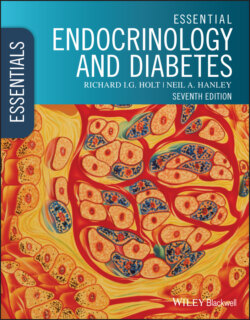Читать книгу Essential Endocrinology and Diabetes - Richard I. G. Holt - Страница 34
Learning objectives
ОглавлениеTo appreciate the organization, structure and function of DNA
To understand mitosis and meiosis
To understand peptide or protein hormone production
To understand how enzyme cascades generate steroid and amino acid‐derived hormones
This chapter aims to introduce some of the basic principles that are needed to understand later chapters
This chapter introduces five major themes: chromosomes and DNA, the synthesis of the three different categories of hormone (peptide and proteins, and hormones derived from either amino acids or cholesterol), and hormone transport in the circulation. How hormones exert their actions is covered in Chapter 3.
The human genome is made up of deoxyribonucleic acid (DNA), assembled into 46 chromosomes in the nucleus (Box 2.1). The DNA contains genes, which are the templates for synthesizing proteins. There are approximately 30,000 human genes that encode proteins. There are many thousands of other genes which are never translated into protein and play important regulatory roles, mostly within the nucleus. Each gene serves as the template for generating many copies of messenger ribonucleic acid (mRNA) by a process called transcription or gene expression. This transcription into mRNA is the means by which the information contained within a single gene becomes amplified and turned into many replica proteins. Specific proteins define the particular phenotype of a cell‐type (e.g. a thyroid cell that synthesizes thyroid hormone rather than the complement of proteins that, for instance, might lead to a beating cardiomyocyte). More commonplace proteins carry out basic functions such as the metabolic processes common to all cells. Proteins on the cell surface act as receptors that initiate intracellular signalling, which in turn is reliant on proteins that function as enzymes. Eventually, this signalling cascade reaches the nucleus and the proteins within it, called transcription factors. These latter proteins bind or release themselves from areas of DNA around genes to determine whether a gene is expressed (i.e. mRNA is transcribed) or silenced.
